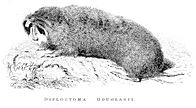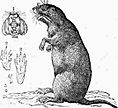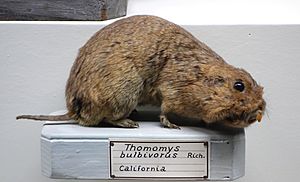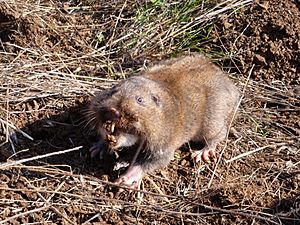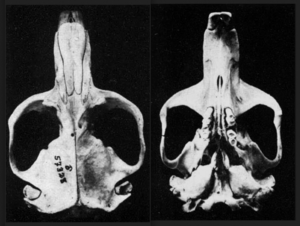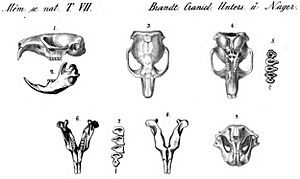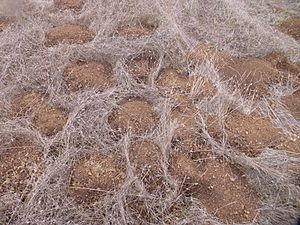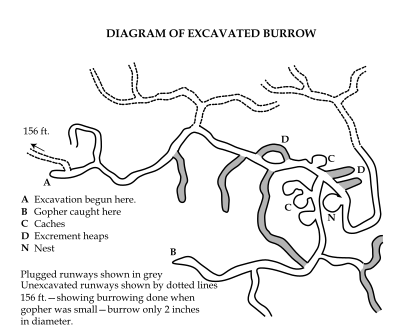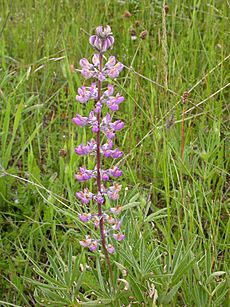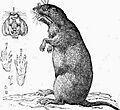Camas pocket gopher facts for kids
Quick facts for kids Camas pocket gopher |
|
|---|---|
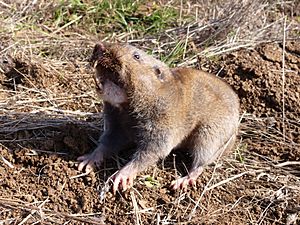 |
|
| Conservation status | |
| Scientific classification | |
| Genus: |
Thomomys
|
| Species: |
bulbivorus
|
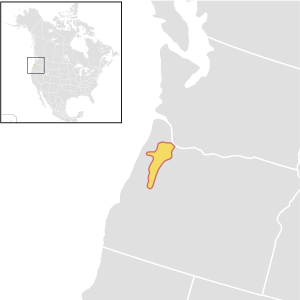 |
|
| Distribution of the camas pocket gopher in the Willamette Valley of northwest Oregon | |
| Synonyms | |
|
List
Diplostoma bulbivorum
Richardson, 1829 Diplostoma douglasii Richardson, 1829 Geomys bulbivorus Richardson, 1837 Ascomys bulbivorus Wagner, 1843 Pseudostoma bulbivorum Audubon & Bachmann, 1854 Geomys (Thomomys) bulbivorus Giebel, 1855 Thomomys bulbivora Brandt, 1855 Thomomys bulbivorus Baird, 1858 Thomomys (subgenus Megascapheus) bulbivorus Elliot, 1903 |
|
The camas pocket gopher (Thomomys bulbivorus) is a type of rodent. It is also known as the camas rat or Willamette Valley gopher. This gopher is the largest member of its group, called the Thomomys genus. It belongs to the Geomyidae family.
Scientists first described this gopher in 1829. It lives only in the Willamette Valley of northwestern Oregon in the United States. The camas pocket gopher is an herbivore, meaning it eats plants. It gathers plants and vegetables in its large, fur-lined cheek pouches. It stores extra food in its many tunnels.
The gopher's fur is usually dull brown to lead-gray. Its color and texture change throughout the year. This mammal has large, front teeth called incisors. These teeth are perfect for digging tunnels, especially in the hard clay soil of the Willamette Valley. Gophers make chattering sounds with their teeth. Male and female gophers purr or coo when they are together. Young gophers make twittering sounds. Baby gophers are born without teeth, blind, and hairless. They grow quickly and stop drinking milk at about six weeks old.
Even though the camas pocket gopher fights fiercely when trapped, it can become calm if kept by humans. Its numbers are generally steady. However, things like cities growing, farms taking over land, and people trying to get rid of them with traps and poisons threaten them. Other animals like raptors (birds of prey) and meat-eating mammals hunt them. They also host several tiny arthropods and worms that live on or inside them. Scientists think that huge floods, called the Missoula Floods, changed the gopher's history. These floods covered the Willamette Valley at the end of the last ice age. This might have caused a genetic bottleneck, meaning only a few gophers survived. These survivors then repopulated the area after the water went away.
Contents
How Scientists Classify Camas Pocket Gophers
Scientists group living things into categories. This helps them understand how different animals are related. The camas pocket gopher is one of six types of pocket gophers found in North America. These groups are called Cratogeomys, Geomys, Orthogeomys, Pappogeomys, Thomomys, and Zygogeomys.
The camas pocket gopher belongs to the Thomomys group. Gophers in this group have smooth front teeth. Other gophers, like those in the Geomys group, have grooves on their teeth. The camas pocket gopher is part of a smaller group within Thomomys called Megascapheus. This group was first made just for the camas pocket gopher in 1903. Later, other gophers were added to it.
The name Thomomys comes from ancient Greek words meaning "heap" and "mouse." This probably describes the piles of dirt the gophers make when they dig. The word bulbivorus comes from Latin words meaning "bulb" and "devour." This suggests the gopher eats plant bulbs.
Early Discoveries and Confusion
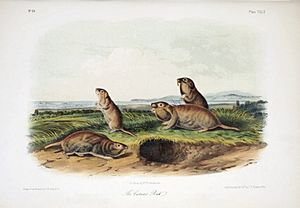
It was tricky for early scientists to figure out the exact classification of the camas pocket gopher. In 1855, a scientist named Johann Friedrich von Brandt was one of the first to call it Thomomys bulbivorus.
Before that, a scientist named John Richardson wrote about the gopher in 1829. He described a specimen found near the Columbia River in Oregon. This area is likely near Portland, where the Willamette and Columbia Rivers meet. This is the northern edge of where these gophers live today. Unfortunately, the original specimen he studied was later lost.
Richardson's descriptions and drawings were sometimes confusing. He first put the gopher in a different group called Diplostoma. He even labeled a drawing with a different name, Diplostoma douglasii. This caused a lot of mix-ups for other scientists trying to identify the animal.
Another scientist, Spencer Fullerton Baird, also added to the confusion. He thought the camas pocket gopher's large size was just because of how it was prepared for display. He also mixed up the camas pocket gopher with the California Gopher. Because of this, old books sometimes showed pictures of the "California Gopher" labeled as Thomomys bulbivorus.
Clearing Up the Mystery
Even though Baird and Elliott Coues studied gophers, they never actually saw a camas pocket gopher. In 1890, Joel Asaph Allen finally got two large adult camas pocket gophers from Beaverton, Oregon. These gophers were much bigger and darker than other gophers scientists had seen. Their skulls and white markings were also different. Allen's findings helped prove that the camas pocket gopher was its own unique species. The California gophers were later identified as Thomomys bottae. They live far south of where the camas pocket gopher is found.
In the late 1800s, James Audubon and John Bachman also studied the camas pocket gopher. They called it the "camas rat." They thought some of the differences described by earlier scientists were just because the specimens were damaged. In 1875, some scientists even thought the camas pocket gopher was a type of northern pocket gopher. By the 1920s, people started calling it the "Willamette Valley gopher."
Modern Family Tree
In 2008, scientists from the University of California, Berkeley and Harvard University used genetics to study the Thomomys group. They found that the camas pocket gopher is quite different from other gophers in its Megascapheus group. This means it's like a "sister" species to the others.
Here's a simplified family tree showing where the camas pocket gopher fits in: {{clade| style=font-size:85%; line-height:85% |label1=Thomomys |
| Thomomys |
|
||||||||||||||||||
| Megascapheus |
|
||||||||||||||||||
Scientists have also studied the genes of the camas pocket gopher. Even though there are no different types (subspecies) of camas pocket gophers, there is a lot of genetic variety within the species. This means that gophers in different populations don't often breed with each other. This is similar to other gophers in the same group.
The genetic variety of the camas pocket gopher is like that of gophers that live in many different places. About 13,000 years ago, a huge event affected all the camas pocket gophers. This event, likely the Missoula Floods, caused a "population bottleneck." This means only a few gophers survived, leading to small, separate groups.
What the Camas Pocket Gopher Looks Like
The camas pocket gopher is the largest gopher in its group, the Thomomys genus. Its fur is dull brown on top and dark gray underneath. It often has white patches on its chin, throat, and around its rear. It also has blackish markings near its ears and nose. The outer ear is a thick edge of skin.
In summer, the gopher's fur is short and rough. In winter, its fur is longer and softer. Young gophers have fur similar to adult summer coats, but it's thinner. You might even see their skin on their belly.
Like other gophers, it has small eyes and ears. Its tail has very little hair. Its shoulders are wider than its hips. It has five claws on each foot. The claws on its front feet are longer than those on its back feet, with the middle claws being the longest.
Female gophers have four mammary glands, which produce milk for their babies. These glands are located in two pairs. The camas pocket gopher looks most like Botta's pocket gopher. You can tell them apart by looking at their skull features, smaller claws, and more even fur color.
Skull and Teeth
The skull of the camas pocket gopher is very strong. Gophers like the camas pocket gopher, with their strong snouts, are part of the Megascapheus group. Male skulls are about 52 millimeters (2 inches) long from the base, or 57 millimeters (2.2 inches) if you include the front teeth. The skull is short and wide.
The gopher has 20 teeth in total. It has one set of front teeth (incisors), one set of premolars, and three sets of molars on both the top and bottom jaws. Its front teeth are very noticeable and stick out. They are smooth with yellow enamel and white tips from digging in the soil. These large, sticking-out upper incisors make the gopher look "buck-toothed." Its lips close behind these teeth, so they are always visible.
Cheek Pouches
Pocket gophers are known for their special fur-lined cheek pouches. They use these pouches to collect and carry food. Muscles control these pouches, allowing the gopher to open and close them. Some muscles pull the pouches forward, and others pull them back. These muscles are strong and help the gopher carry a lot of food.
Where Camas Pocket Gophers Live
The camas pocket gopher lives in the Willamette Valley in Oregon. It also lives in areas around the Yamhill River and other rivers that flow into the Willamette River. Its home range goes from Eugene in the south to Portland and Forest Grove in the north. It also extends west to Grand Ronde.
The Willamette Valley has clay-rich soils that become very hard when dry. The gopher's strong front teeth are perfect for digging in these tough conditions. Good soil drainage and enough plant food are key for the gopher's home. They usually don't live in wet areas because their tunnels would flood.
You can find them in grassy and bushy areas. They also live in farm fields in the Willamette Valley, including fields of alfalfa, wheat, and oats. They can also be found in areas where the land has been disturbed, as long as the ground is similar.
Long ago, the Willamette Valley experienced huge floods. These were the Missoula Floods, which happened about 13,000 years ago. One massive flood filled the Willamette Valley with water up to 122 meters (400 feet) deep. This flood covered almost all of the camas pocket gopher's living area.
It's believed that gophers lived in the valley before the flood, but no fossils have been found. The Chehalem Mountains, which are higher, likely provided safe places for gophers to survive. After the water went down, these survivors repopulated the valley in scattered groups. The mountains probably limited how much gophers from different areas could mix their genes. The Willamette River, which is narrow and slow, doesn't seem to stop gopher populations from mixing.
How Camas Pocket Gophers Behave
The gopher has been credited with being one of the most vicious animals known for its size. It has a great deal of courage and fights a man savagely until an opportunity for escape is offered, then it turns and runs as rapidly as possible, attempting to hide from its pursuer.
—H. M. Wight, Economic Entomology: Pamphlets
The camas pocket gopher usually lives alone. It is active all year round and does not hibernate (sleep through winter).
The gopher spends most of its time digging tunnels to find food. The hard clay soils of the Willamette Valley make this a challenge. The gopher's front claws are not strong enough to dig through the clay, especially when it's dry. But its large, sticking-out front teeth are perfect for this job. The tunnels built by the camas pocket gopher can be very long, some more than 240 meters (260 yards). These tunnels are about 90 millimeters (3.5 inches) wide and can be up to 0.91 meters (3 feet) deep.
Even though they mostly live underground, gophers sometimes gather food near their tunnel entrances. Dandelions seem to be their favorite food. They also use dandelions to build their nests. During breeding season, male gophers will enter female gophers' tunnels. Males and females might make purring or cooing sounds when they are together. Mothers seem to comfort their young by making soft sounds, and the young gophers twitter back.
The camas pocket gopher can be aggressive when it feels threatened. One scientist described it as "morose and savage." However, it can become calm easily if kept by humans. Female gophers are easier to tame than males. Another small rodent, the gray-tailed vole, also uses camas pocket gopher tunnels. Other mammals that share the gopher's home range include shrews, moles, rabbits, chipmunks, squirrels, and skunks.
Life Cycle and Ecology
| Age (weeks) | Weight | Length | Description |
|---|---|---|---|
| Birth | 6.1 g (0.22 oz) | 50 mm (2.0 in) | No hair, no teeth, no cheek pouches |
| 2 | 23 g (0.81 oz) | 90 mm (3.5 in) | Developing hair |
| 3 | 35.5 g (1.25 oz) | 108 mm (4.3 in) | Crawling, eat solid food |
| 4 | 53.6 g (1.89 oz) | 123.5 mm (4.86 in) | Pockets developed |
| 5 | 70.5 g (2.49 oz) | 153 mm (6.0 in) | Eyes open |
| 6 | 86 g (3.0 oz) | 164 mm (6.5 in) | Weaned |
The breeding season for the camas pocket gopher can vary. Some reports say it starts in early April and lasts through June. Others have seen pregnant females in late March. In areas with a lot of irrigation, the breeding season might last longer, even into early September.
About four young gophers are born in a litter, but sometimes as many as nine have been reported. When born, the babies are blind, hairless, and have no teeth. They weigh about 6.1 grams (0.2 ounces) and are 50 millimeters (2 inches) long. In their first six weeks, they learn to crawl, grow cheek pouches, open their eyes, and switch from milk to solid food. By six weeks, they weigh about 86 grams (3 ounces) and are 164 millimeters (6.5 inches) long. Some reports suggest that a female gopher can have more than one litter in a season. Gophers likely become old enough to breed by the next year's breeding season. Males are fully grown by then, but females might continue to get bigger.
Not much is known about how long camas pocket gophers live or what causes them to die. They are probably hunted by meat-eating mammals. Their bones have been found in the pellets (regurgitated food) of great horned owls.
Camas pocket gophers can have parasites like mites, lice, fleas, roundworms, and flatworms. Their tough skin might protect them from some fleas that bother other gopher species. Specific mites and a chewing louse have been found on them. Two types of parasitic worms, a nematode and a cestode, were first found in the stomachs of camas pocket gophers.
Camas Pocket Gophers and Humans
Camas pocket gophers can cause big problems for farmers, so they are sometimes seen as pests. They damage crops like clover, alfalfa, and vetch. Gophers might eat these crops or harm their roots while digging. This can dry out the roots. Their digging can also damage the roots of fruit trees. Root crops like potatoes, carrots, and parsnips are especially at risk. Gophers might eat them on the spot or drag them into their burrows to store.
The dirt they dig up can cover grass, making it hard for livestock to graze. It can also damage newly sprouted grains. In 1918, it was estimated that camas pocket gophers caused $1.5 million in losses each year in the Willamette Valley.
However, gopher activities can also be helpful. Their tunnels help to aerate the soil, which means air gets into it. This helps the soil hold water better after rain or snow. Buried plants can also break down and add nutrients to the soil, making it healthier.
To control gopher populations in farm areas, people have tried poisoning dandelions, clover, carrots, and parsnips. Because camas pocket gophers are larger than other gophers, regular gopher traps might not catch them. Poison baits and gases might also fail because gophers sometimes block off parts of their tunnels. Gophers can also cause local floods if their digging damages levees (walls that prevent flooding).
To protect sensitive habitats, the Oregon Department of Transportation and the Institute for Applied Ecology trap and move camas pocket gophers. For example, near Philomath, Oregon, they are working to protect a rare flower called Kincaid's lupine. This threatened flower is the main food source for the endangered Fender's blue butterfly. The gophers are moved to a new spot far away from these important flowers.
Protecting the Camas Pocket Gopher

In 2014, NatureServe said the camas pocket gopher was "vulnerable." This was due to worries about cities growing, habitat loss, and efforts to get rid of them. However, the IUCN (International Union for Conservation of Nature) says the gopher is of "least concern." This means its population is stable. The IUCN notes that the gopher is common in its range. Studies show that gopher numbers can quickly bounce back after traps are removed. The species also seems to adapt well to changes in its environment.
Both the IUCN and other groups are concerned about the loss of the gopher's habitat. This is happening because of cities expanding and more land being used for farming. The total area where the camas pocket gopher lives is less than 20,000 square kilometers (7,700 square miles). This area, the Willamette Valley, is home to 70 percent of Oregon's human population.
While there might be some protected areas in the valley, many are for protecting waterfowl for hunters. Wet areas are not good for camas pocket gophers because their tunnels would flood. In areas that are better for gophers, like disturbed lands and farms, they might be seen as pests. This can lead to efforts to get rid of them with poison and traps.
Images for kids
-
Skeleton at the Museum of Osteology in Oklahoma



